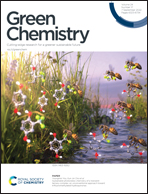Conversion of polyethylene terephthalate into pure terephthalic acid through synergy between a solid-degrading cutinase and a reaction intermediate-hydrolysing carboxylesterase†
Abstract
At temperatures supporting a glass transition in solid polyethylene terephthalate (PET), thermostable cutinases access the backbones of PET chains at the liquid–solid interface and hydrolyse ester bonds through endolytic and exolytic cuts. These lead to the production of three degradation intermediates [oligoethylene terephthalates (OETs), bis-hydroxyethyl terephthalate (BHET), and mono-hydroxyethyl terephthalate (MHET)] and two terminal degradation products [terephthalic acid (TPA) and ethylene glycol (EG)]. All five products are water-soluble to different degrees and diffuse away from PET to reach progressively higher concentrations in the surrounding solution, where they accumulate in proportion with the binding of cutinase to PET (through hydrophobic and cation–pi interactions). Importantly, however, the binding of cutinase to PET (which is essential for PET degradation) results in depletion of cutinase in solution, negatively impacting the conversion of degradation intermediates into terminal reaction products. The immediate and direct consequence of this is that the produced TPA and EG are contaminated by OET, BHET and MHET and, therefore, become unfit for recycling through re-condensation into PET. Here, we describe a ‘two-enzyme’ solution to the problem, consisting of a cocktail containing equimolar amounts of a PET-degrading enzyme [leaf-branch compost cutinase (LCC)] and a degradation intermediate-hydrolysing enzyme [Thermus thermophilus carboxylesterase (TTCE)]. The former produces OET, BHET, MHET, TPA and EG at PET's surface, while the latter works in solution to degrade the produced OET, BHET and MHET into TPA and EG. Through their synergy, the enzymes produce pure TPA and EG in yields that are 30–100% higher than those obtained with LCC alone.



 Please wait while we load your content...
Please wait while we load your content...